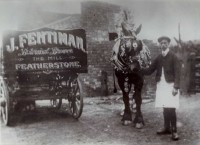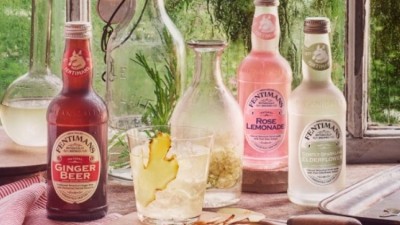In association with Fentimans
Key drink trends for summer 2021: Premium pours, gin growth and independent brands

During more than a year of on-again, off-again trade due to the Covid-19 pandemic, Brits have registered record Google searches for drinks recipes, seen cocktail shakers fly off virtual shelves and shared “cupboard cocktails” in their droves – Quarantini, anyone?
All this means that after months of broadening their horizons behind closed doors, drinkers are returning to pubs and bars prepared to indulge a previously undiscovered sweet tooth, for example, or study a drinks list rather than simply ordering “the usual”.
Here, The Morning Advertiser and premium soft drink and mixer brand Fentimans have distilled five of the drinks sector’s biggest summer trends as pubs and bars resume trading.
Splashing out on premium pours
Pimms and Rose
Premium expressions of accessible mixers – for example, Rose Lemonade versus the standard clear lemonade can elevate spirit and mixer drinks into the premium space – provide a price increase opportunity while still being recognisable.
A Pimms and Rose Lemonade is a prime example of this. A premium, botanical twist on summer staple Pimms and Lemonade, mix 50ml of Pimms No. 1 and 200ml of Fentimans’ Rose Lemonade in a glass built with ice and garnished with a seasonal fruit cup.
A gin and Rose Lemonade also appeals to consumers who are looking for a premium long mixed drink but dislike the flavour of quinine – a particularly evident stance among younger consumers.
According to research by CGA the premium drinks category – worth £19m in the UK – is growing across all categories post-lockdown with almost half (47%) of consumers willing to pay more for a better-quality serve.
As such, the category has observed a market-wide 12% annual increase in value of premium mixer sales, while spirit segment value has grown by 21% year-on-year.
A recent CGA survey also found that one-in-four consumers missed “treating” themselves in the on-trade during lockdown.
With all this in mind, it’s widely forecast that reopening the on-trade will kick premium drink sales into overdrive.
Steve Latto of the Criterion bar in St Andrews, Scotland – the winner of the Best For Spirits category at the 2019 Great British Pub Awards – explains that when his site was allowed to open after the first lockdown, he noticed a 45% increase in sales of more niche and premium spirits, wine and beer.
“When we conducted some analysis on the products that we were selling, more of it could be tracked back to our order at the table web portal,” he explains. “Our customers were going through the categories and taking more time to browse our whole selection rather than just ordering what they would normally.
“The increase in premium correlated with the decrease in house spirits and wines and giving us a better gross profit percentage and cash margin.”
Latto adds that he believes returning customers consider on-trade outings as more of an occasion than previously, are prepared to splash out on premium pours as a result.
Additionally, the founder of Klynk ventures – a firm which works closely with new and disruptor brands to connect them to retailers and shoppers – Hamish Clarke, flags premiumisation as a “long-term trend” which has been impacting both the on and off-trade over a number of years.
“In essence there are two growth areas within premiumisation worth noting,” he explains. “Affordable or accessible premiumisation and then pure luxury.
“Younger, more engaged consumers are actively seeking out new flavours, experiences and combinations and are willing to pay more for it, provided the brands have a strong story of transparency,” he continues.
“Consumers are really looking to add something extra to their standard drink be it a new mixer or a new spirit with a unique botanical or indeed a strong environmental angle.”
Transparent tipples
From botanical to bottle
At its Northumberland home in the heart of the British countryside, Fentimans’ dedicated flavour department skilfully extracts, blends and layers bespoke flavours from a carefully selected range of plants, herbs and natural botanicals sourced from across the globe.
Fentimans’ approach offers total traceability of all ingredients, from botanical to bottle.
No, we’re not sounding the death knell for cloudy lemonade.
CGA data serves up the notion that, post-Covid, consumers are increasingly conscious of what they are eating and drinking – with explicit natural, ethical and wellbeing credentials more important than ever.
It also found that 90% of those quizzed agreed that they would stop purchasing drinks brands with a lack of transparency and that three quarters (75%) would switch to drinks brands that openly provide product information.
Klynk Ventures’ Clarke believes “trust” is a key issue facing larger brands.
“Smaller, more open and digitally engaged brands are able to take consumers with them on their journey,” he explains. “For a digitally engaged consumer this is increasingly more important as they are consumer brands that are aligned to their own values on provenance and traceability.
“This transparency runs through supply chain, production and founders' stories,’ he continues. “For us at Klynk Ventures we can see that brands that have created good products, at a fair price and have nothing to hide seem to garner a lot of consumer interest.”
Clarke adds that in response to the growth of social media, his firm has coined the phrase “democratisation of choice” given the extent to which consumers have the power to leave a drinks brand high and dry.
“A key area to consider is brands that can talk about a degree of naturalness,” he suggests. “Products which are locally sourced or have clean label ingredients are in high demand from consumers.”
Independent spirit
Independent since 1905
Since 1905, the knowledge, expertise and passion for making exquisitely crafted botanical drinks has been handed down through four generations of the Fentimans family.
Today, while the brand’s mixers are paired with spirits in over 85 countries around the world, Fentimans remains 100% independent and family owned, uncompromisingly dedicated to making the world's best soft drinks and mixers.
One of the drinks industry’s Covid symptoms has seen customers increasingly plump for independent and artisanal brands in response to the devastating impact of lockdown on small businesses.
According to CGA, roughly half (52%) of on trade consumers stated an increasing desire to support independent suppliers post-lockdown on both moral grounds and due to perceived product quality.
For operators, considering how stocked brands can shape a venue’s perception is crucial in tapping this trend. Whether a venue is part of a larger chain or a small standalone, back bars and fridges full of craft or independent brands can shape its image in the eyes of customers.
Latto adds he has seen the Criterion bar’s customers gradually migrate towards more artisanal brands versus more ubiquitous back bar serves over time – and that the independent drinks bubble looks unlikely to burst any time soon.
“Without doubt we’ve seen this move,” he explains. “It’s not a new trend, but the uptick after the first lockdown was substantial, both from the customers and from the local suppliers themselves.
“We focused our promotions and collaborations so that we were always championing local independent brands from gin, whisky, hot toddies and beer,” he adds.
Latto explains that the enthusiasm operators get when they engage with an independent brand makes for a better experience for the publican, staff and customer, in his opinion.
“The suppliers were fantastic in supporting local businesses like ourselves, running their own campaigns on social media and letting their followers know where they could buy their products and likewise when we were shut we advertised where you could buy their products direct online from them,” he adds.
“There was a real camaraderie within the trade during and after the first lockdown that I am sure will continue.”
Getting an all-rounder in
Hendricks and Rose
Fentimans is the fastest selling premium carbonated soft drink brand in UK pubs according to CGA, with its Rose Lemonade enjoyed as either a standalone or in spirit and mixer serves.
Try it on its own or mix 50ml of Hendricks gin and garnish with cucumber.
A large number of venues have already moved to streamline their drinks offer in the name of profit after a challenging year of on-again, off-again pandemic trade.
As such, rate of sale will very likely become one of the key metrics when deciding on which brands to stock and – beyond tonic water – solid all-rounders that can sell as either a standalone soft or spirit mixer look like vital inclusions in post-lockdown drink offers.
For example, Fentimans’ iconic Rose Lemonade and Ginger Beer (the UK’s market leader) are primarily soft drinks, but can be paired with stalwart spirits such as gin and rum to create premium spirit and mixer serves. Their versatility can drive rate of sale as well as efficiency of fridge space.
“Innovation is a key component to any business,” the Criterion bar’s Steve Latto adds. “We worked with a number of local and national brands to help differentiate our offerings.
“We came up with a number of different serves for products, working closely with Kingsbarns Distillery we used their blended Wemyss malts for our Old Fashioneds – three variants, sweet, smoky and spiced based on their different whiskies.
“We also worked with Whitely Neil to develop our hot drink offerings for the colder evening where we mixed out spiced gin punch,” he says.
Latto adds that another switch he saw from consumers was a willingness to experiment – an urge that stemmed from having confidence in brands.
“No more so than the non-alcoholic ranges that we introduced,” he explains. “This segment quadrupled in sales and was mainly led by innovation by the brands in giving consumers confidence to try their no alcohol products as they had already bought into the full-strength product.”
Gin ‘still important’
Bringing variety and cost efficiency to gin
Catering for a broad taste spectrum through serves including Pink Grapefruit, Valencian Orange and Pink Rhubarb Tonic Waters to Tropical Soda, Fentimans’ flavoured mixer range can bring variety and extra colour – a key driver of purchase – to any bar’s gin range.
Rather than breaking the bank and back bar with a vast array of gins, Fentimans’ authentic flavoured mixers offer operators the chance to tailor a core gin range to consumer tastes and add eye-catching colour to a clear gin serve.
For instance, Fentimans’ Valencian Orange Tonic Water adds a warm and enticing hue to gin, with orange segment and rosemary sprig garnish creating a dazzling summer serve.
Gin is here to stay and doesn’t show any signs of slowing. Pre-pandemic, it was the fastest growing spirits category, with premium pours growing 21% in volume and 23% in value.
Therefore, providing a range of mixers to meet growing demand from drinkers buying into the category is important – especially if they can offer colour and variety.
Unsurprisingly, gin is the top selling spirit category at the Criterion, according to Latto.
“Like many publicans I am sure, we are finding it difficult to keep up with all the variants that are coming out and the move away from a heavy juniper flavour to a sweeter palate has attracted a wider audience to the category,” he says. “But it seems like every day there is a new flavour or variant coming out.
“We are continuing to stock up to 90 gins at present and rotating out the low rate of sale products and concentrating on local distilleries and using that as a selling point rather than having 300 gins,” he adds.
Fentimans has a range of flavoured mixers that can bring variety to serves and range without the cost outlay of stocking large numbers of gins. A range of coloured, flavoured mixers can bring variety to a smaller gin range and make them sell faster with a much lower cost outlay.
What’s more, Klynk Ventures’ Clarke recalls that a recent gin strategy his firm delivered fixed two key drivers of category growth in his thoughts.
“Lateral growth in the category will come through flavour and format differentiation,” he says.
“Consumers will also be looking for enhanced gin drinks too so we think that a range of unique gins that can cater for this consumer as well as a strong mixer offering will keep the gin consumer engaged and coming back for more.”












